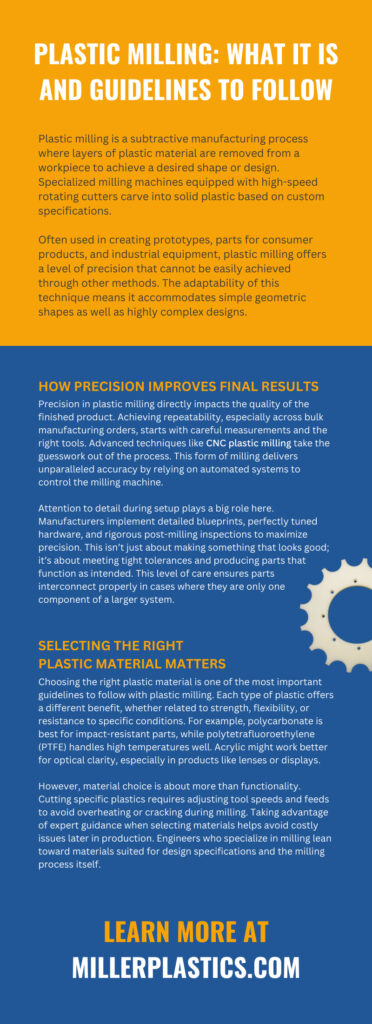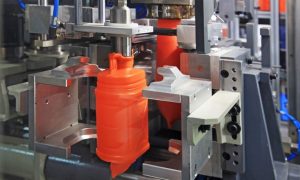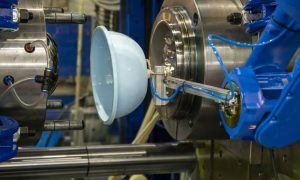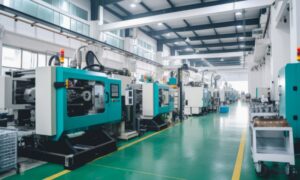Plastic milling has become a critical process in industries ranging from aerospace to medical manufacturing. It involves shaping solid pieces of plastic into precise forms that meet specific dimensional and functional needs.
If you’re curious about what plastic milling is and the guidelines to follow, you’ve come to the right place. This guide will walk you through everything you need to know, from the basics to specific techniques used for accuracy and durability.
What Is Plastic Milling?
Plastic milling is a subtractive manufacturing process where layers of plastic material are removed from a workpiece to achieve a desired shape or design. Specialized milling machines equipped with high-speed rotating cutters carve into solid plastic based on custom specifications.
Often used in creating prototypes, parts for consumer products, and industrial equipment, plastic milling offers a level of precision that cannot be easily achieved through other methods. The adaptability of this technique means it accommodates simple geometric shapes as well as highly complex designs.
This method is typically preferred due to its compatibility with various plastic types, which include acrylic, polycarbonate, and acrylonitrile butadiene (ABS). Due to its versatility, plastic milling is a go-to technique for engineers and manufacturers who value mechanical precision. More specifically, industries like automotive and health care depend on this form of milling to produce reliable components that withstand their environments and requirements.
Why Choose Plastic Over Metal for Milling?
While metal milling remains a popular process, plastic milling provides distinct advantages for specific applications. For instance, plastic materials are lighter than metal, which makes them ideal for industries prioritizing weight reduction, such as aerospace.
Additionally, plastics resist corrosion and operate reliably in environments where moisture and chemicals would damage metal parts. This unique characteristic makes milling plastic components highly beneficial in settings exposed to harsh substances.
On top of that, plastic milling is generally quieter and faster because the softer material reduces wear on the machinery. Manufacturers also recognize that plastics allow for more cost-effective production, particularly for large-scale projects. These benefits all contribute to the rising demand for expertly milled plastic components.
How Precision Improves Final Results
Precision in plastic milling directly impacts the quality of the finished product. Achieving repeatability, especially across bulk manufacturing orders, starts with careful measurements and the right tools. Advanced techniques like CNC plastic milling take the guesswork out of the process. This form of milling delivers unparalleled accuracy by relying on automated systems to control the milling machine.
Attention to detail during setup plays a big role here. Manufacturers implement detailed blueprints, perfectly tuned hardware, and rigorous post-milling inspections to maximize precision. This isn’t just about making something that looks good; it’s about meeting tight tolerances and producing parts that function as intended. This level of care ensures parts interconnect properly in cases where they are only one component of a larger system.
Selecting the Right Plastic Material Matters
Choosing the right plastic material is one of the most important guidelines to follow with plastic milling. Each type of plastic offers a different benefit, whether related to strength, flexibility, or resistance to specific conditions. For example, polycarbonate is best for impact-resistant parts, while polytetrafluoroethylene (PTFE) handles high temperatures well. Acrylic might work better for optical clarity, especially in products like lenses or displays.
However, material choice is about more than functionality. Cutting specific plastics requires adjusting tool speeds and feeds to avoid overheating or cracking during milling. Taking advantage of expert guidance when selecting materials helps avoid costly issues later in production. Engineers who specialize in milling lean toward materials suited for design specifications and the milling process itself.
Why Milling Speed Is Important
The speed at which the cutting tools turn during plastic milling can make or break the quality of the final product. Faster isn’t always better, particularly when working with softer types of plastic prone to tearing or melting. Manufacturers typically adjust spindle revolutions per minute (RPM) to align with the material’s properties and design complexity.
Slower speeds often translate to cleaner cuts, while higher speeds may work for specific types of plastic that can withstand the stress. Consistency here contributes to superior results, especially for intricate designs. Balancing speed and material properties requires experimentation and a firm understanding of the material used.
Surface Finish Enhancements
Surface imperfections don’t just affect aesthetics; they can hinder mechanical performance by compromising the integrity of the part. Polishing, buffing, or treating the surface after milling enhances the final product.
The cutting tool’s sharpness impacts the surface. Using dull tools increases imperfections by dragging across the material rather than slicing smoothly. Sharp, well-maintained tools combined with slower finishing passes improve the overall finish. For businesses that prioritize flawless, polished components, focus on the surface finish.
Maintaining Consistency in Batch Orders
Consistency across multiple parts in a single order is paramount for any industrial application. When creating a series of components, even minor deviations can compromise their functionality. Computer-aided systems for plastic milling address this issue by maintaining tight tolerance levels across batches.
Another factor influencing consistency is the routine maintenance of milling machines. Uncared-for machinery introduces inaccuracies over time, costing the manufacturer money and potentially harming their reputation. By incorporating regular inspections, manufacturers prioritize long-term reliability over short-term convenience.
Best Practices for Setting Up Your Milling Machine
Preparation is key to a successful milling project. Properly secure the plastic workpiece so it doesn’t shift during machining, as unwanted movement can compromise measurements. Adjust feed rates, tooling, and spindle speed based on the material for more precise control over the cutting process.
Software automation assists operators with detailed simulations before using the machine. Visualizing the machining process lets operators tweak variables for better efficiency and accuracy. Well-prepared setups translate into smoother production cycles and higher-quality outcomes.
How Plastic Milling Drives Manufacturing Innovation
Plastic milling continues to expand possibilities for custom, scalable manufacturing solutions. Milling bridges the gap between initial concepts and mass production, which enables industries to innovate while maintaining cost efficiency. Whether for smaller, specific components or large-scale production runs, this process empowers businesses to remain competitive in rapidly evolving markets.
Plastic milling offers nearly unlimited potential when done right. Miller Plastic Products specializes in manufacturing expertly milled plastic parts by combining industry-leading expertise with a commitment to quality. Contact us today to learn how our services can unlock the full capabilities of your next project.





